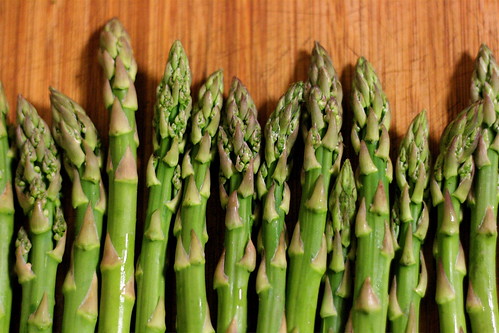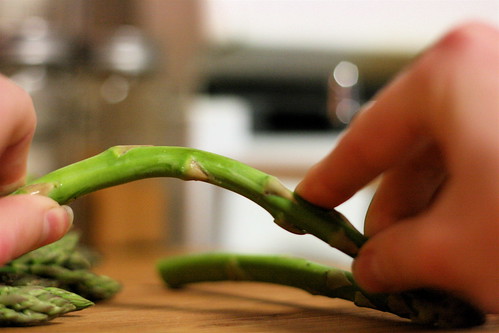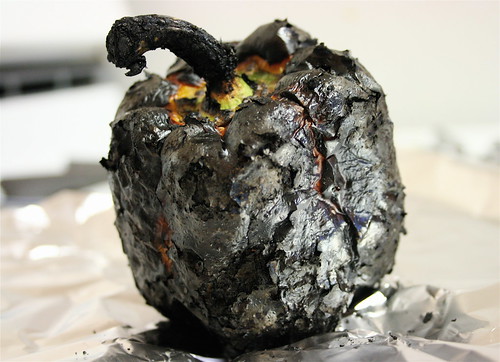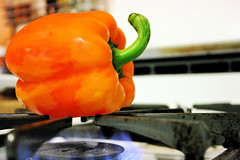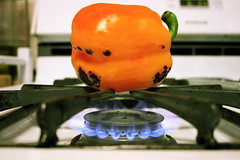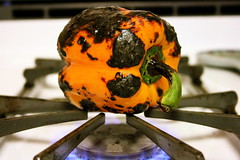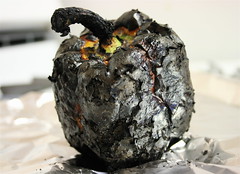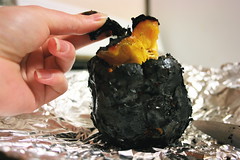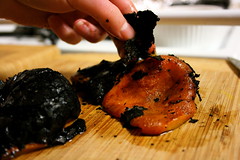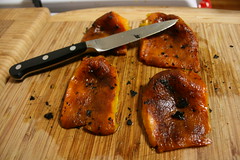How to Buy and Prep Asparagus
Welcome to asparagus season! Are you as excited as I am?
Asparagus is a lovely vegetable, but much like brussels sprouts, it is a vegetable much abused. And also like sprouts, you can start off on the wrong foot even before you get then back to your kitchen.
We all look for ripe berries, unbruised apples, and juicy tomatoes. So don’t buy just any bunch of asparagus you see at the store. You want to look for a few key qualities:
1. Very thin to fairly thin in diameter
2. Tight, compact heads
3. Firm, unwrinkled stalks
Any time a bunch of asparagus fails to meet one of these requirements, it’s a sign that the asparagus is old in one way or another. If you find thick asparagus, it was harvested too late and will be bitter, stringy, and even woody. If the head is loose and spindly – same deal. If the stalks are wrinkly and collapsing, they’ve been on the shelf too long and are starting to decompose. Run away! Run very far away. I hear string beans are nice!
I bet you’re wondering how thick is too thick. My ideal asparagus is the same thickness as a pencil, but these aren’t always available. The same thickness as a regualr Sharpie marker is definitely acceptable. Once you get into magic marker range, or the diameter of an American dime, you’ve gone too far. Pencils and Sharpies. That’s what you’re shooting for. I have a contingency plan for maybe-too-thick asparagus, but more on that later.
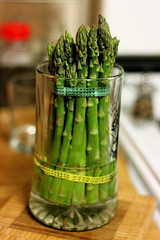 Unless you’re going to eat them immediately after you get home, you’re going to need to store your asparagus. You should treat your asparagus like a bouquet of flowers. Chop 1/2 inch off the ends and place the entire bunch in a glass with a little water in the bottom. Take a quart-sized ziplock and invert it over the top and store in the fridge. Your asparagus will stay fresher longer.
Unless you’re going to eat them immediately after you get home, you’re going to need to store your asparagus. You should treat your asparagus like a bouquet of flowers. Chop 1/2 inch off the ends and place the entire bunch in a glass with a little water in the bottom. Take a quart-sized ziplock and invert it over the top and store in the fridge. Your asparagus will stay fresher longer.
When you’re ready to use the asparagus, you need to go through at least one more step, but it’s fun because it involves mystical asparagus magic. The head of the asparagus is the most tender, and as the stalk gets thicker, it gets tougher. There is a magic point somewhere between the tip and the end of the asparagus that separates tasty-tender from icky-tough. You may not know where this point is, but your asparagus does. Observe:
Hold your asparagus with both hands, about two inches from the tip and the end. You can chant softly if you want. Gently bend the asparagus…
…until it snaps. You have reached asparagus enlightenment. You see, it will naturally break at a point of resistance, and that point is where the stem is too tough to be enjoyable. Do this for all your asparagus.
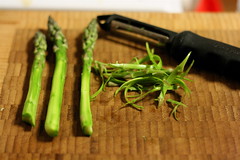 If you bought asparagus that may be a little too thick, or you feel like being super fancy, you can peel your asparagus. It’ll take some of the stringy-ness away, but I’ve seen fancy restaurants do this even with perfectly thin asparagus. Use a vegetable peeler and peel from tip to stem, being careful not to pass over the same spot twice. You can end up with pretty sad looking asparagus if you peel them too much.
If you bought asparagus that may be a little too thick, or you feel like being super fancy, you can peel your asparagus. It’ll take some of the stringy-ness away, but I’ve seen fancy restaurants do this even with perfectly thin asparagus. Use a vegetable peeler and peel from tip to stem, being careful not to pass over the same spot twice. You can end up with pretty sad looking asparagus if you peel them too much.
Now you’re ready to cook. How? There are a bunch of ways. You can grill, saute, roast, boil, or steam, to name a few. Steaming is one of the more popular ways, but I prefer to boil mine in a shallow pan of water. Asparagus can go from DONE! to WHOA! OVERDONE! fairly quickly, so I like to be able to see it and poke it as much as I want when I’m cooking it – it’s harder to do that in my all-metal steamer. And to be fair, my mother also cooked asparagus in a pan of shallow water, so I’m not surprised that it’s my default method. Experiment and see what works for you.
Below is a simple recipe for asparagus, but there are really so many tasty ways to enjoy this vegetable. If you need a place to start, this is a good one, but definitely explore other ways of cooking it. Roasting and grilling especially. Yum.
